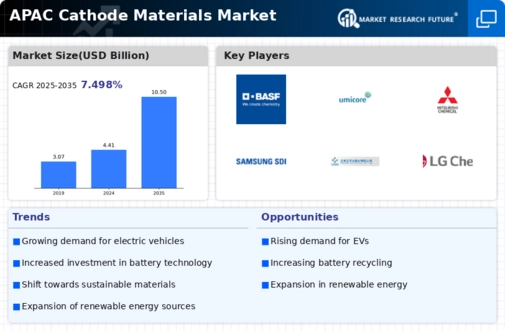The APAC Cathode Materials Market has gained significant traction over the past few years, driven by the increasing demand for electric vehicles and energy storage systems that require advanced battery technologies. This heightened interest has attracted a plethora of both established players and new entrants in the region, leading to intense competition. The dynamic marketplace is characterized by rapid technological advancements, collaborations, and strategic partnerships aimed at enhancing production capabilities and product offerings. As manufacturers strive to innovate in cathode materials, the focus on sustainability and cost-efficiency is increasingly shaping competitive strategies.
Players in the market are not only vying for market share but also looking to establish long-term relationships with battery manufacturers to ensure a steady demand for their products in the booming electric vehicle and energy storage sectors. BASF has carved a niche for itself in the APAC Cathode Materials Market by leveraging its extensive research and development capabilities. The company boasts a strong presence in the region, focusing on producing high-performance cathode materials that cater to lithium-ion batteries.
One of BASF's key strengths lies in its commitment to innovation, which is evidenced through its investment in developing new cathode materials that enhance battery efficiency and longevity. Additionally, BASF benefits from its vast global supply chain, allowing it to optimize production and distribution processes effectively within the APAC region. The company's deep understanding of local market dynamics and preferences has further helped it to tailor its offerings to meet the specific needs of customers in different APAC markets, thereby enhancing customer satisfaction and loyalty.
Umicore has established itself as a formidable competitor in the APAC Cathode Materials Market, specializing in advanced materials for various battery technologies. The company's portfolio includes high-quality cathode materials that are primarily aimed at electric vehicle and energy storage applications, underscoring its commitment to sustainability and environmental stewardship. Umicore's strategic presence in the APAC region is supported by its investment in state-of-the-art production facilities that adhere to stringent quality standards, enabling the company to meet growing customer demands effectively. The company also engages in key partnerships and collaborations to bolster its market offerings and increase production capabilities.
Furthermore, Umicore has pursued strategic mergers and acquisitions to strengthen its position in the market, ensuring that it remains at the forefront of technology and innovation. By focusing on research-driven solutions, Umicore continues to enhance its competitive edge, making it a preferred choice among manufacturers in the APAC Cathode Materials Market.





















